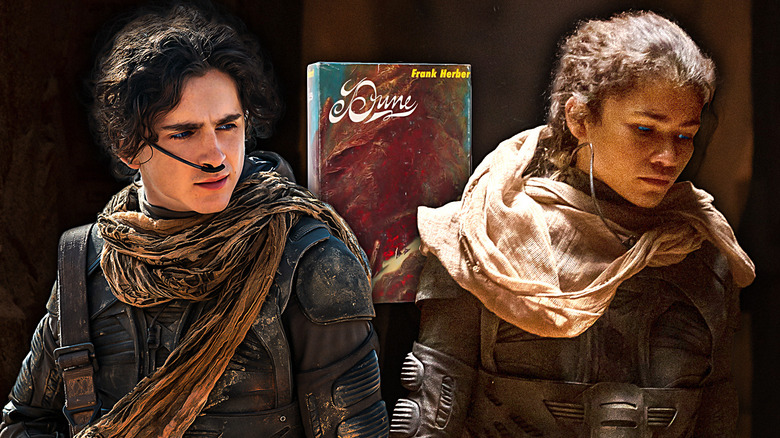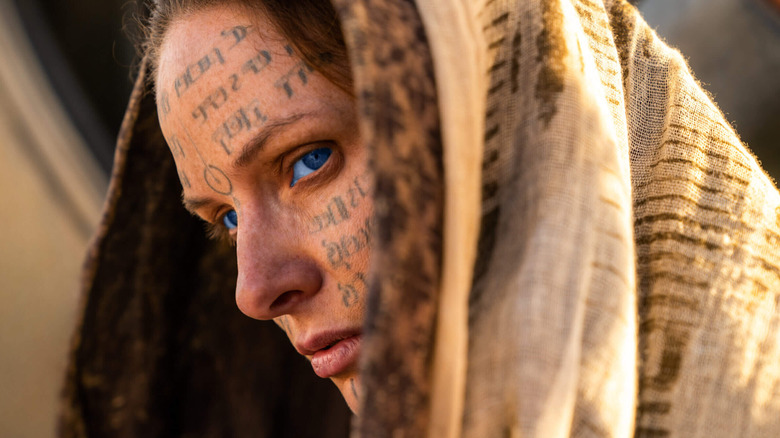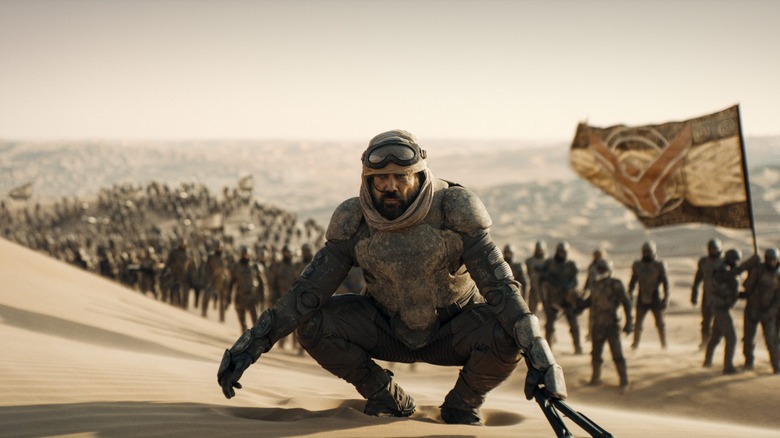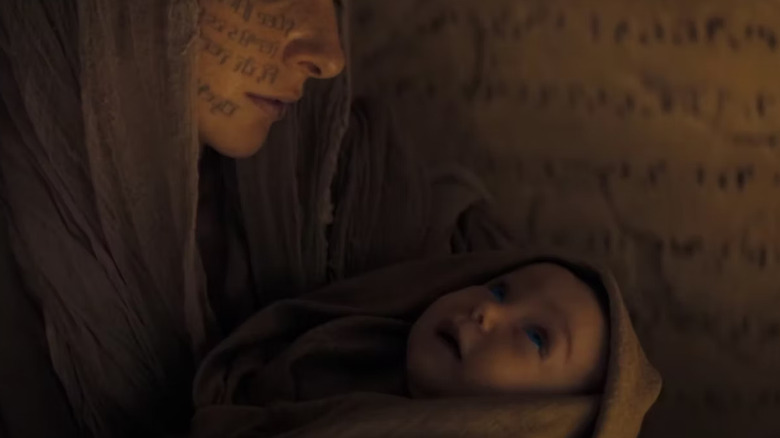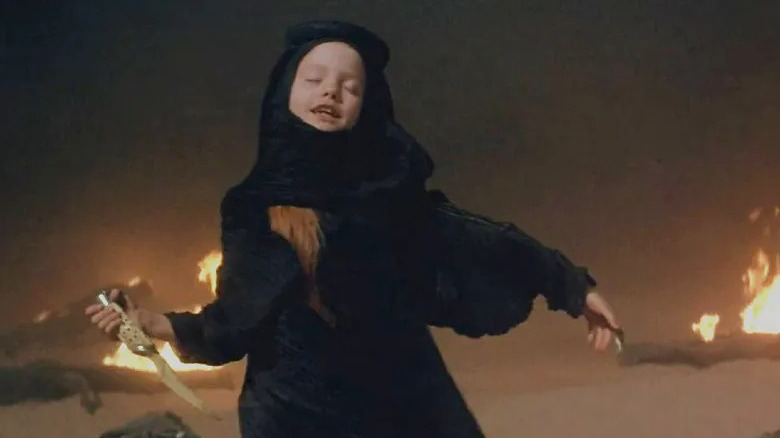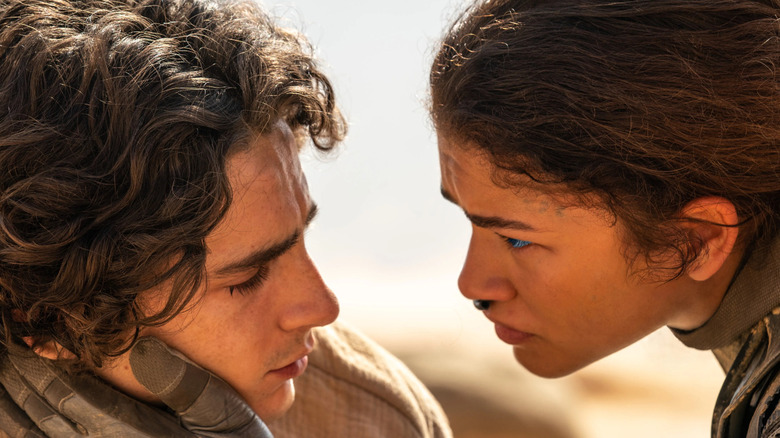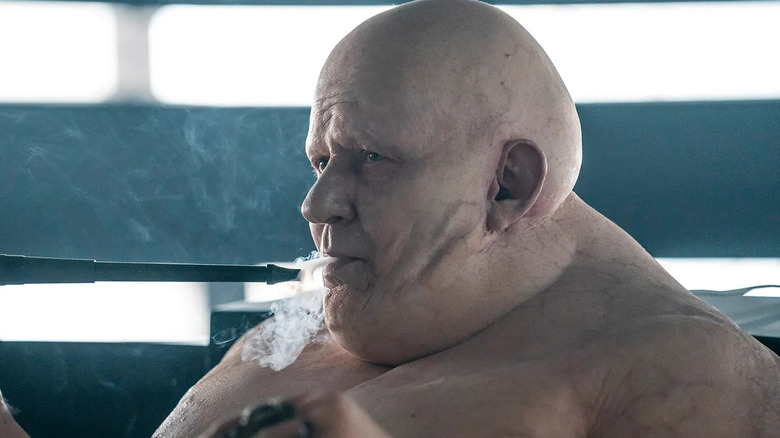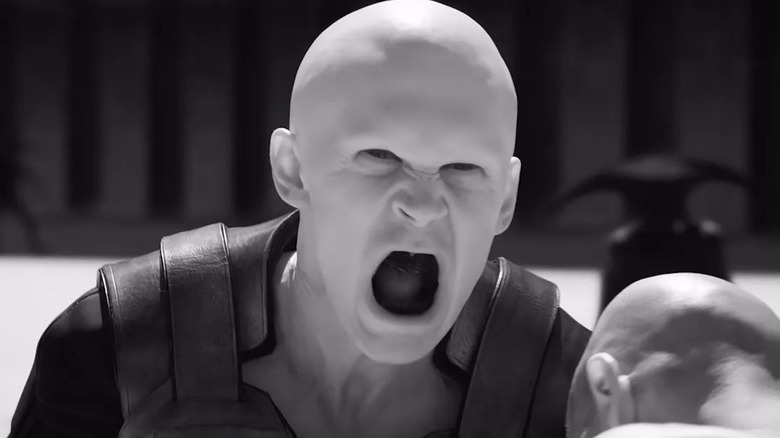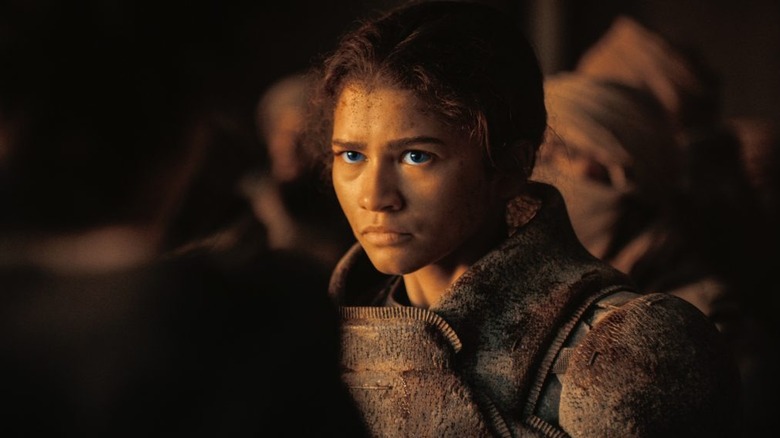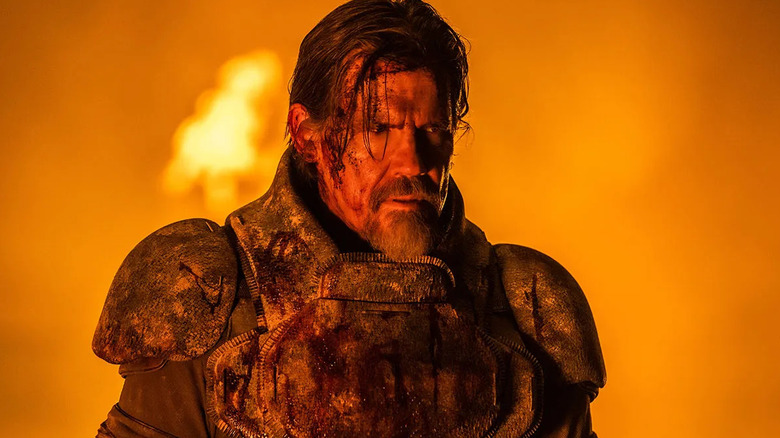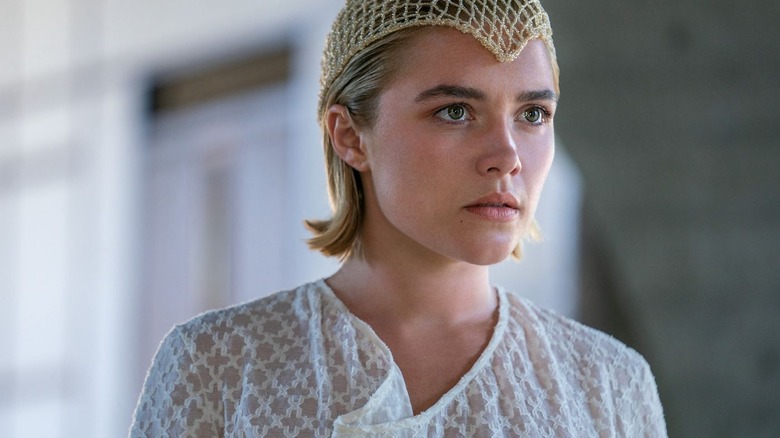Things Dune: Part Two Gets Totally Wrong From The Book
Contains spoilers for "Dune: Part Two"
2021's "Dune: Part One," directed and co-written by Denis Villeneuve, was both a massive box office hit and a critical success. The sequel, 2024's "Dune: Part Two," has proven to be just as successful, wowing the critics and performing well at the box office. Villeneuve's two "Dune" films cover the entirety of Frank Herbert's first "Dune" novel, which came out back in 1965. The story centers on the young, aristocratic Paul Atreides (Timothée Chalamet), who leaves his peaceful home planet of Caladan along with his family to start a new life on the desert planet Arrakis at the behest of the Emperor.
After Paul's father Duke Leto (Oscar Isaac) is betrayed and killed, Paul and his mother Lady Jessica (Rebecca Ferguson) are forced to escape into the wild desert. They meet up with the native Fremen, led by the warrior Stilgar (Javier Bardem). The Fremen have been led to believe that Paul is their long-prophesied messiah, and, after proving himself in battle, he and his mother are accepted into their ranks.
While the films stick to the novel they're based on pretty closely, there were still some changes made as "Dune" went from page to screen. From character motivations to the exclusion of certain events, here's how "Dune: Part Two" differs from the original book.
Lady Jessica is far more radical in the movie
Lady Jessica is a far more cold and ruthless character in "Dune: Part Two" than she is in the book. In fact, Lady Jessica almost plays an antagonistic role in this version of the story, as she's the one actively radicalizing the Fremen toward Paul's divinity, hoping to use this as a way to control them. In both the film and novel, Lady Jessica is a member of the Bene Gesserit, a secretive cabal of powerful women with special abilities. They can use something called the Voice to control people's actions, and they train in a devastating martial art called the Weirding Way.
The Bene Gesserit are also obsessed with political control. They have engineered specific bloodlines over generations to create the Kwisatz Haderach, a messianic figure they can use to gain more power. This is also accomplished with the help of something called the Missionaria Protectiva, a kind of religious engineering. Over centuries, the Bene Gesserit seeded fake myths and prophecies around the universe to be exploited when the time was right. This includes the Lisan al Gaib legend on Arrakis, which is why part of the myth involves his mother being a Bene Gesserit.
After Lady Jessica takes over as the Reverend Mother of the Fremen in "Dune: Part Two," she takes her fundamentalist extremism to its nadir to make sure her son Paul gains absolute power. This is a departure from the book's more overtly maternal (and relatively passive) character.
The subplot about Northern and Southern tribes was invented for the film
In the original "Dune" novel, Paul and his mother travel with the Fremen together rather than getting separated for most of the story, like they do in "Dune: Part Two." This change works well for the film, though, as it greatly expands upon the subplot of the Missionaria Protectiva and the Bene Gesserit's use of false prophecies to subjugate and manipulate the native Fremen.
In the film, the Fremen are split into Northern and Southern tribes. The Southerners are more zealous than the Fremen from the North. Fremen leader Stilgar is from the South, and, as such, he believes in Paul's divinity as Lisan al Gaib almost immediately. Chani (Zendaya), meanwhile, is from the North and is more skeptical. This narrative change allows for the internal struggles that Paul goes through in the book (he feels uneasy about the false myths of the Lisan al Gaib) to be externalized and dramatized through the conflict with his mother and his fraught conversations with Chani.
This change from page to screen arguably improves Paul's character arc: While book Paul is understandably concerned about his destiny as a Galactic Emperor who brings about an interstellar genocide, he's not quite as reluctant as film Paul is. This makes it all the more tragic when Paul starts to realize that he cannot escape his dark destiny.
The time jump from the book doesn't happen
Another major change that "Dune: Part Two" makes is condensing the timeline. In the book, around two-thirds of the way through, Frank Herbert employs a multi-year time jump. This means that Lady Jessica (who, as alluded to in "Dune: Part One," is pregnant with the late Duke Leto's child) has given birth. She welcomes a daughter, who she names Alia. Paul and Chani grow closer during the time skip, and she also gives birth to a child, a son named Leto II (named after Paul's beloved father).
Denis Villeneuve and co-writer Jon Spaihts decided to jettison the time jump entirely, which is understandable — and possibly even necessary — for cinematic pacing. Some unfortunate cuts have to be made as a result, such as the aforementioned babies. It's easy to understand why the film went down this route, but because it all takes place in a matter of months instead of years, it does make the Fremen's trust in Paul's divinity as the prophesied Lisan al Gaib a little harder to believe.
Alia influences matters in a different way
By far one of the biggest departures "Dune: Part Two" makes is the exclusion of Paul's younger sister Alia Atreides. As mentioned above, there is a multi-year time jump in the book, and Alia is born in that time. She's able to walk around and talk like an adult, despite only being a few years old. This is because Jessica drank the Fremen's Water of Life while pregnant. Like Jessica, Alia gains the knowledge of every Reverend Mother that came before her while still in the womb. When Alia is finally born, she is what is called "pre-born" — even though she's an infant, she has adult memories and experiences.
Alia's bizarre situation would obviously require a lot of lore and exposition to explain. Not to mention, a little girl who acts like an adult can come off as a little goofy on film (as it unfortunately does in David Lynch's 1984 adaptation, despite the young actor's best efforts). "Dune: Part Two" gets around this in a clever way — much of Alia's narrative purpose from the book is fulfilled while she's still in the womb (voiced by Anya-Taylor Joy). She helps to radicalize Jessica and she pushes Paul toward his destiny while paving the way for her role in a third "Dune" movie. At the end of the day, seeing Alia as a little girl wasn't really necessary.
Paul's big tipping point doesn't happen in the film
The other child born in the book's time jump is Paul and Chani's son Leto II. Of course, since the time jump doesn't happen in "Dune: Part Two," Leto II isn't in the film. In the book, Leto II plays a huge role in Paul's arc — the child is tragically killed before the climax of the story, which obviously has a huge impact on the protagonist's mental state.
At the end of the "Dune" novel, before Paul and his Fremen army overwhelm Padishah Emperor Shaddam IV's Sardaukar forces on Arrakis, Paul receives a transmission informing him that Leto II has been killed in an attack. It's heavily implied that this event is the tipping point for Paul, as his anger over Leto II's death leads to him accepting his destiny as the genocidal Muad'Dib.
Because of the film's condensed time frame, it makes sense that Leto II's introduction and subsequent tragic death weren't included in "Dune: Part Two." Leto II was left out of David Lynch's "Dune," as well, probably for similar reasons. However, the birth of Leto II and his sad death do occur in the forgotten "Dune" miniseries that starred William Hurt.
Baron Vladimir Harkonnen's death is changed
The vicious, cunning, and ostentatious "Dune" villain Baron Vladimir Harkonnen is most notable for his unique appearance, as his overly-rotund physique necessitates wearing high-tech floating devices called "suspensors" to move around at all. In all filmed versions, these belt-mounted suspensors also allow the Baron to hover menacingly in the air. However, the Baron also possesses an intelligent, ruthless political mind that lets him see things multiple steps ahead of everyone else.
In both Denis Villeneuve-directed "Dune" films, star Stellan Skarsgård plays the Baron with an extra amount of quiet menace that doesn't even exist in the books, where he's much more flamboyant. Baron Harkonnen's role in the story, as one of the primary antagonists who mainly works in the background, remains the same in the book and film; however, a big change is made in "Dune: Part Two" in the way the Baron's story ends.
This is because, in the books, Baron Harkonnen is killed by Paul's child sister, Alia, when she scratches and poisons him with a hidden Gom Jabbar. However, due to the aforementioned deleted time jump and condensed narrative timeline, Alia isn't born in the film, so instead Paul himself is the one who kills him, telling him coldly, "You died like an animal," as he brutally stabs the Baron in the neck. This is an understandable switch due to the other adaptation changes, and it offers more foreshadowing of Paul's inevitable moral descent.
Feyd-Rautha Harkonnen is portrayed differently
For fans of the book, "Dune: Part Two" finally introduces Paul's villainous rival, Baron Harkonnen's vicious nephew Feyd-Rautha Harkonnen, played with aplomb by "Elvis" star Austin Butler. While it made sense for Denis Villeneuve's first "Dune" film to omit the character — as Feyd-Rautha's story doesn't start until the second half — his introduction in the sequel was much appreciated nonetheless.
However, while Butler gives a strong and memorable performance in "Dune: Part Two," the film's characterization of Feyd-Rautha is quite different than it is from the books. For one, his physical appearance is drastically altered, with author Frank Herbert describing Feyd-Rautha as "a dark-haired youth of about sixteen years, round of face and with sullen eyes." In the film, Feyd is instead seemingly aged up considerably (Butler himself is 32 years old), and rather than dark hair, Feyd in "Dune: Part Two" is bald and sickly pale, looking like a sexier Nosferatu.
Even more extensive are the changes to Feyd-Rautha's characterization from page to screen. Feyd is much more aggressive and physically threatening in the film — as evidenced when he beats up his brother Glossu Rabban "The Beast" Harkonnen (Dave Bautista) in a scene created for the movie — while in the book he's depicted instead as charismatic, conniving, and politically cunning. Book-Feyd even almost outsmarts the Baron at one point in an attempted assassination plot, something Film-Feyd doesn't seem capable of.
Chani is much more defiant and skeptical at the end
Another massive change that "Dune: Part Two" makes from Frank Herbert's book — and a welcome one — is how the film handles the character of Chani. In the book, Chani is pretty much devoted to Paul Muad'Dib once they fall in love, and is a devoted follower to him until the very end. While Book-Chani initially and understandably has trepidation about Paul's marriage with Irulan, she is nonetheless aware of the political necessity of Paul marrying Irulan, and goes along with it without question.
However, in the film version, Chani — as played by Zendaya — is much more rebellious and defiant, which makes sense for how the character was set up, even in the book. Fremen women, like Chani, are practically equal to men in their society and are expected to hunt, ride the giant sandworms, collect water, and so on, so it's logical that she'd be strong-willed and opinionated.
Also, unlike Chani on the page, Film-Chani is aware of the Bene Gesserit "Missionaria Protectiva," or at the very least is suspicious of Paul's divinity and the validity of the "Lisan al Gaib" myth, while also aware of its use as colonial control. Film-Chani even challenges Paul during his rousing — but maniacal — speech to the Southern Fremen. At the end of the film, she understandably runs away after watching Paul propose to Princess Irulan (Florence Pugh), with the film ending on Chani's distraught face.
Gurney Halleck killing The Beast Rabban
There are many valid reasons for the changes made to the original "Dune" novel in "Dune: Part Two." Some include scenes in the book that were cut to save screen time, characters that were deleted or composited to streamline the narrative, and events that were modified or shifted around for thematic clarity. However, some changes seem like they were made as a direct corrective to the original text.
One such example is when loyal Atreides warrior-turned-spice-smuggler Gurney Halleck (Josh Brolin) takes his bloody revenge on the brutish Glossu Rabban "The Beast" Harkonnen, killing him during the film's final battle. This makes a lot of narrative sense, as it's explicitly stated that Rabban had previously fought and tortured Gurney in the past and that Rabban is the one who gave Gurney the distinctive inkvine scar on his face. Even in the book, Gurney wishes to take revenge on his former torturer.
However, in the book, that vengeance never comes. Instead, Rabban is killed when the Arrakian natives he's been mercilessly subjugating at the Baron's behest get sick of him and his Harkonnen thugs squeezing them economically and militarily, causing them to riot, overwhelm, and murder him and his men. Admittedly, there's some poetic justice in Rabban being taken out by those he had been mistreating, but it doesn't have the same impact as Gurney doing the job himself.
There are more scenes with Princess Irulan
Princess Irulan (Florence Pugh), is given a lot more to do in "Dune: Part Two" than in the entirety of the first "Dune" book. To be clear, that's not saying much: in the movie, all Pugh's (admittedly impeccably-dressed) Irulan does before the final scene is walk around her castle on her home planet, talking to her father Emperor Shaddam IV (Christopher Walken) and the other Bene Gesserit — including Reverend Mother Gaius Helen Mohiam (Charlotte Rampling) — who are all conspiring against the Atreides.
However, in the book, Princess Irulan does even less. She isn't even physically mentioned until the very end, when she arrives on Arrakis with her father in his makeshift throne room before Paul raids it. Irulan, however, is also cited in the book as the author of various historical and biographical accounts of "Muad'Dib," which we see glimpses of at the start of each chapter.
This is a smart and necessary change. While Princess Irulan isn't important in the first book (except as a plot device to allow Paul to ascend the throne in a final act of revenge against her father, The Emperor), she's an extremely important character in the sequel "Dune Messiah," which "Dune: Part Two" director Denis Villeneuve has expressed interest in directing. It also allows her to be a conduit for other characters to spout important political and story exposition, which is expressed mostly in inner monologues in the book. And yes, her outfits rule.
